molecule
Latest

Molecule-level 'CT scans' could lead to faster drug discovery
Scientists like to use x-rays when determining chemical structures to develop drugs, but it's an agonizingly slow process. As they need large, pure crystals, it can take weeks or even years to produce something big enough for studying. However, that time might be cut down to a matter of minutes. Researchers have developed a CT scan-like technique that can quickly and easily detect the shape of very small organic molecules. It borrows elements of the x-ray technique, but doesn't demand the large crystals.

'Robot chemist' could use AI to speed up medical breakthroughs
Scientists can only do so much to discover new chemical reactions on their own. Short of happy accidents, it can take years to find new drugs that might save lives. They might have a better way at the University of Glasgow, though: let robots do the hard work. A research team at the school has developed a "robot chemist" (below) that uses machine learning to accelerate discoveries of chemical reactions and molecules. The bot uses machine learning to predict the outcomes of chemical reactions based on what it gleans from direct experience with just a fraction of those interactions. In a test with 1,000 possible reactions from 18 chemicals, the machine only needed to explore 100 of them to predict study-worthy reactions in the entire lot with about 80 percent accuracy.
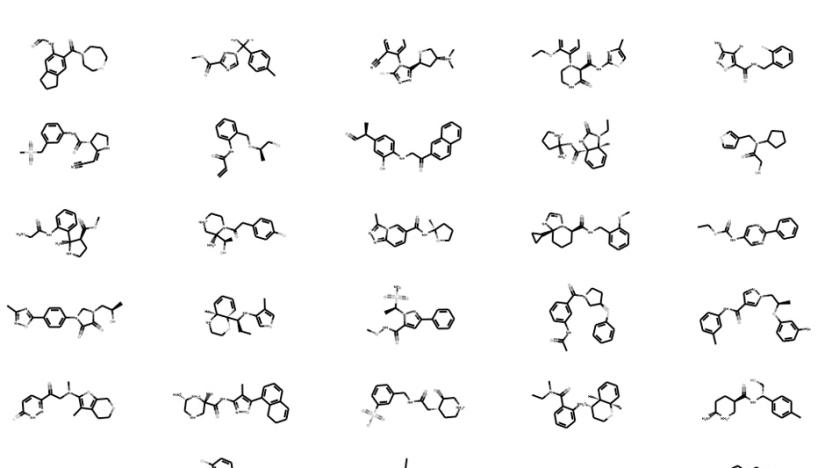
MIT researchers automate drug design with machine learning
Developing and improving medications is typically a long and very involved process. Chemists build and tweak molecules, sometimes aiming to create a new treatment for a specific disease or symptom, other times working to improve a drug that already exists. But it takes a lot of time and a lot of expert knowledge, and attempts often end with a drug that doesn't work as hoped. But researchers at MIT are using machine learning to automate this process. "The motivation behind this was to replace the inefficient human modification process of designing molecules with automated iteration and assure the validity of the molecules we generate," Wengong Jin, a PhD student in MIT's Computer Science and Artificial Intelligence Laboratory, said in a statement.
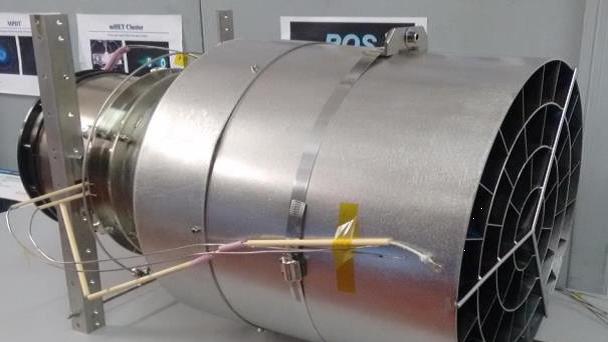
ESA's air-breathing thrusters help keep satellites alive longer
Satellites could soon remain in orbit for years on end thanks to new technology that turns air molecules into propellant. A European Space Agency (ESA) team has developed an electric thruster that collects molecules from the top of the atmosphere and gives them electric charges so they can be accelerated and ejected to provide thrust. This could create a new class of satellites able to operate in orbit for long stretches.
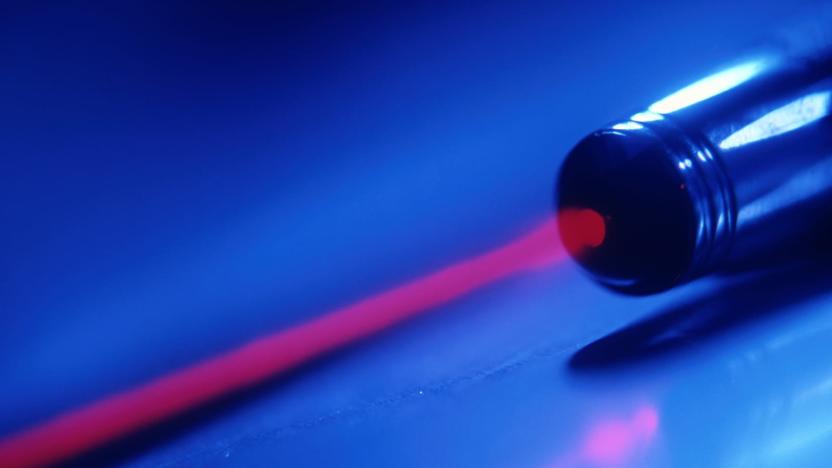
New laser technology could improve how scientists study molecules
We use lasers for a lot of things, from cutting metal to improving eyesight, but lasers have their limitations. One major holdup is that they can only emit certain types of light. Researchers have gotten around this particular limitation by using what are known as optical parametric oscillators, which allow regular laser light to be converted into other wavelengths of light that may be useful for certain areas of research. One example is studying how molecules behave. However, these gadgets have their limitations too. They typically have weak outputs and they require extreme stability and precision, making them hard to use outside of highly controlled lab environments. But researchers at Stanford may have found a way around this issue and their work could make these systems more efficient and easier to use.
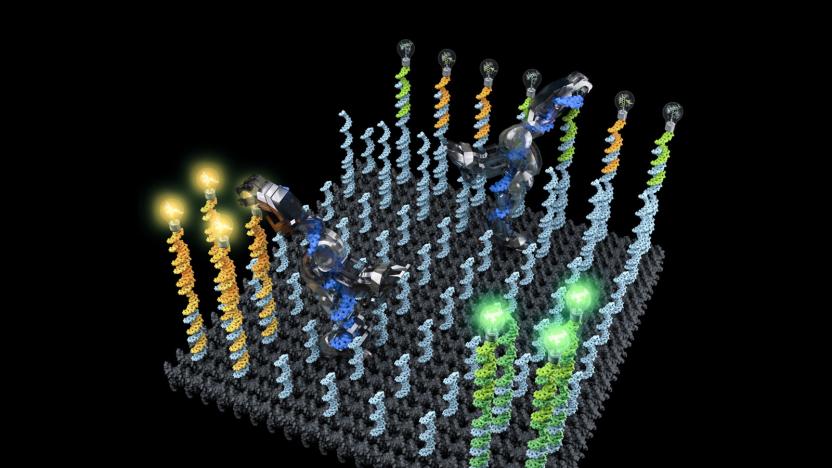
DNA 'robots' could sort molecules in your blood
Robots are already good at sorting things, so wouldn't it be nice if they could sort things out on a much smaller scale? They might soon. Caltech researchers have developed a 'robot' made from a single DNA strand that autonomously picks up molecules and moves them to specific places. It certainly doesn't look like a machine (what you're seeing above is merely representative), it behaves like one. Each segment is a collection of nucleotides that automatically performs a specific task: one segment tells the bot where to go, while separate limbs help it move around and grab molecules.
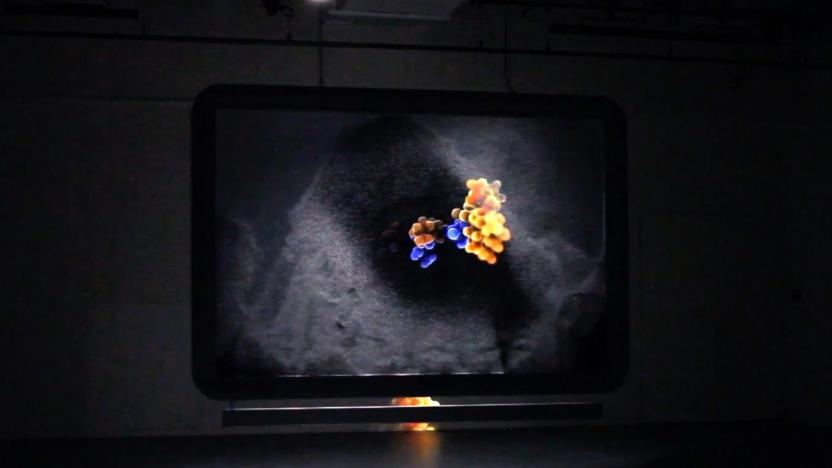
Bead screen depicts atomic life in glorious low resolution
In an era where virtually flawless 8K screens are a reality, it's easy to forget that low-resolution displays have their own appeal -- a flickering tube TV can exhibit more character than most modern sets. And a team of artists and scientists (at France's Millimètre and Harvard University) are taking full advantage of that emotional pull. Their Life in Picoseconds exhibit uses an "Atom Screen" made of thousands of beads to depict a protein molecule in a purposefully low resolution. The project uses 70 software-guided fans to suspend beads between plastic panels, turning them into pixels when you shine light on them. The effect is fuzzy, jittery and tenuous, as if the energy and fragility of the atoms is reflected in the display itself.

Crowdsourced research predicts what molecules smell like
As of now, the only way to tell how something smells is to actually take a sniff. That is to say, there's no observable, scientific measure we know of that can predict how we'll perceive a specific odor. In comparison, things are a little more cut and dried with sights and sounds; because humans use wavelengths to process what they see and hear, we generally agree on, say, how we expect a specific color to look. But scientists now seem to be making progress on the olfactory front: New crowdsourced research has brought scientists closer to predicting a molecule's smell based solely on its chemical properties.

Nanomachines just won the Nobel Prize in Chemistry
If you want to know how far nanotechnology has come, you only need to ask the Royal Swedish Academy of Sciences. It just awarded the Nobel Prize in Chemistry to researchers Bernard Feringa, Jean-Pierre Sauvage and Sir J. Fraser Stoddart for their work on the "design and synthesis of molecular machines." All three have been instrumental to making nanomachines possible. Sauvage kicked things off in 1983, when he linked ring-shaped through a mechanical bond instead of the usual electron-sharing bond. Stoddart carried the torch when he slipped a moving molecular ring on to an axle in 1991, while Feringa built the first molecular motor in 1999.

Scientists catch a classic quantum experiment on camera
If you know a bit about quantum physics, you've likely heard of the Schrödinger's Cat concept used to explain superpositions: a cat in a box with a poison flask is at once alive and dead until you look inside. Researchers have produced this oddball state in the lab before, but they're now using it to create the most detailed X-ray movies of molecules they've seen so far. A team at the SLAC National Accelerator Laboratory first blasted an iodine molecule with an optical laser, splitting the molecule into simultaneous excited and relaxed states. When the scientists hit the molecule with X-rays afterward, the light scattering off of both states created an X-ray hologram showing the excited state. After that, the SLAC group only had to capture enough of these holograms to create a movie.

ICYMI: Better walking bot and an anti-aging breakthrough
try{document.getElementById("aol-cms-player-1").style.display="none";}catch(e){}Today on In Case You Missed It: Georgia Tech overhauled its DURUS robot to walk with a human-like gait that makes it the most efficient bipedal robot. Scientists at the EPFL did some solid research into the pomegranate fruit that shows it can counteract disease and extend the life of worms by 50 percent and endurance in rodents by 40 percent. Human trials are happening now. You can see the latest 3D bone printer here and what the FBI has been doing with iris scans, here. As always, please share any interesting tech or science videos you find by using the #ICYMI hashtag on Twitter for @mskerryd.

Molecules in space may show how life formed on Earth
Scientists have known for a while that the molecular ingredients of life can be found in nearby comets and meteorites, but it's now clear that those building blocks exist much, much further away from home. A research team has used spectral analysis to discover evidence of organic chiral molecules, the "mirror-image" molecules that are key to biology as we know it, in the Sagittarius B2 cloud near the heart of the Milky Way. This doesn't meant that life is forming in space, but it does suggest that the necessary molecular properties can appear in space first and transfer to planets through meteorite impacts.

Scientists capture images of molecules forming atomic bonds
For most of us, molecular bonding only really exists as a classroom concept. Some scientists at Lawrence Berkeley National Laboratory can now claim more tangible knowledge, however: they're the first to have taken truly clear snapshots of bonding in progress. While trying to create graphene nanostructures and observe them with an atomic force microscope, a lab team spotted molecules forming their individual, atom-level links during a chemical reaction. The resulting shots were nearly textbook material, too -- as the molecules were neatly placed on a flat surface, the researchers identified the order and nature of each bond. While the images will only be immediately useful for the nanostructure research at hand, they may add a welcome dash of reality to future chemistry lessons.

Researchers store memory bit on a lone molecule, could pave the way for petabyte SSDs
The Karlsruhe Institute of Technology (KIT) just deflated the size of a bit down to a solitary nanometer -- the length of an organic molecule. The international research team managed it by first embedding a magnetized iron atom into a molecule made up of 51 atoms, then taking advantage of so-called memristive and spintronic properties. By applying a current, they flipped the atom's magnetic charge, altering the resistance of the molecule as well -- which they subsequently measured, storing a bit. Compared to a typical magnetic drive which needs 3 million atoms per bit, a device made this way could theoretically store 50 thousand times as much data in the same size -- and would be an all-electric device, to boot. If the research ever pans out, a terabyte magnetic drive could turn into a 50 petabyte solid state unit -- hopefully ready in time for all those 4K home movies you'll need to store one day soon.

Inhabitat's Week in Green: solar tulip, new discovered molecule and a colossal statue of Coca Cola crates
Each week our friends at Inhabitat recap the week's most interesting green developments and clean tech news for us -- it's the Week in Green. The big news that had the world of green transportation buzzing this week was Tesla's unveil of its brand new Model X luxury car and we also saw the blazing fast Lightning GT EV hit the track for the first time. We also shined light on the futuristic solar-powered SPV car while Mitsubishi's i-MIEV electric car stole the greenest vehicle title from the Honda Civic and the Boulder EV became the first electric truck capable of hitting 70 mph. We were also excited to announce that San Francisco is set to launch its electric bike sharing program, French cyclists won the controversial right to run red traffic lights, and Volkswagen unveiled its Think Blue Beetle, which is made from 2,805 pieces of recycled trash.Energy news sent shock waves around the world this week as Inhabitat reported that the US approved its first nuclear power plants in 30 years and the temperature of Japan's damaged Fukushima nuclear plant suddenly soared up to 45 degrees celsius. We also saw an energy-generating "Solar Tulip" power tower spring up in Spain, and a 10-year-old girl discovered a new molecule that stands to improve energy storage. Meanwhile, we brought you the scoop on the world's next tallest skyscraper in Azerbaijan and industrial giant AAB announced plans for a worldwide electric vehicle charging network.In recycled design news, we saw a colossal statue made from 4,200 Coca Cola crates rise up over Cape Town and we shared a set of larger than life beasts made from recycled motorcycle parts. We also brought you a brilliant line of lamps made from recycled e-waste and a set of LEGO-like Earth Blocks made from coffee beans and tea chaff. Last but not least, we showcased an electronic suit that treats nerve disorders, and since Valentine's day is on the way we took a look at BIG's interactive LED heart sculpture in NYC, 6 adorable DIY cards, and 6 simple DIY V-Day gifts.

Biological computer can decode images stored in DNA chips, applications remain unclear
Scientists from the Scripps Research Institute and Technion–Israel Institute of Technology have taken biological computing one step further, with a new molecular machine capable of decoding images stored on a DNA chip. Though it's referred to as a "biological computer," the researchers' machine isn't much like a CPU at all -- unless your CPU was manufactured in a test tube filled with a smoothie of DNA molecules, enzymes and ATP. Once they found the right mix, the team proceeded to encrypt images on a DNA chip and used their Turing machine-like creation to decode them, with fluorescent stains helping to track its progress. The above image, read from left to right, gives a more literal idea of what the system can do -- basically, it takes a hidden image and extracts a given sequence. Storing data on DNA isn't anything new, but decrypting said data in this fashion apparently is. The applications for this kind of organic computing remain a bit fuzzy, but it's pretty clear that whatever follows probably won't look anything like a typical computer. The team's findings were recently published in a paper for the journal Angewandte Chemie, the abstract for which is linked below. For a slightly more readable explanation, check out the full press release after the break.

Dutch scientists develop half million euro, 'affordable' super laser
The folks at Eindhoven University of Technology (TU/e) have lovingly referred to their latest contribution to the world of science as the "poor man's X-FEL." An X-FEL, or X-ray Free-electron Laser, is like a super strong video microscope that converts electrons to X-rays to observe high-speed molecular movement. TU/e's super laser alternative depends solely on a very specific bunching of electrons to do the same thing, allowing for a much smaller (it fits on a tabletop), much cheaper setup. With an estimated cost of half a million euro, the laser is hardly cheap, but it's far more affordable than the competition: Stanford's X-FEL runs hundreds of millions of dollars, and measures a whole kilometer. TU/e researchers admit that their laser can't do everything that an X-FEL can, but, hey, you get what you pay for. Up next for TU/e? In vitro pork products. Yummy.

Chemists craft molecular keypad lock
While the folks behind the AACS could probably use a few pointers about constructing a sufficient lock of their own, a group of scientists at the Weizmann Institute of Science in Rehovat, Israel have crafted a molecule-sized "keypad lock" that "only activates when exposed to the correct password, a sequence of chemicals and light." Organic chemist Abraham Shanzer and his colleagues suggest that their invention could "lead to a new level of safeguards for secret information," but we tend think the infamous hackers of the world would inevitably crack the code. Nevertheless, the molecule -- dubbed FLIP -- houses a core linker that mimics a bacterial compound that binds to iron, and attached to it are two molecules that respectively can glow either blue or green. Using three "buttons," which just so happen to be an acidic molecule, an alkaline compound, and ultraviolet light, the lock can be "opened" if given the right sequence of chemicals and light, and there's a grand total of two noticeable results possible. Interestingly, the researchers have insinuated that their creation could be used to recognize "when certain sequences of chemicals (like harmful toxins) are released in the body," but we haven't heard a 10-4 from the US Army just yet.[Via Yahoo, thanks, Antonio H.]

UC Berkeley's disease-detecting E-Nose
The last time we checked in on electronic nose technology, hospitals were using the still-boutique devices for very specialized institutional work such as monitoring nasty bacteria outbreaks. Recent breakthroughs by a company called Nanomix, however, could make E-Noses a standard tool in every patient examination room, with UC Berkeley researchers using the company's tech to design cheap devices that can "sniff out" disease-laden molecules in samples a person's breath. Nanomix's "Sensation" detection platform uses multiple, configurable carbon nanotube-based sensors to instantly provide a reading from a puff or air, although the exact diseases that the battery-powered devices will be programmed to detect have not been announced. We do know that the first application of this tech will probably be for carbon dioxide detection, allowing emergency personnel to immediately determine the efficacy of breathing tubes used to stabilize patients on board an ambulance.








